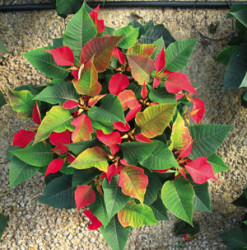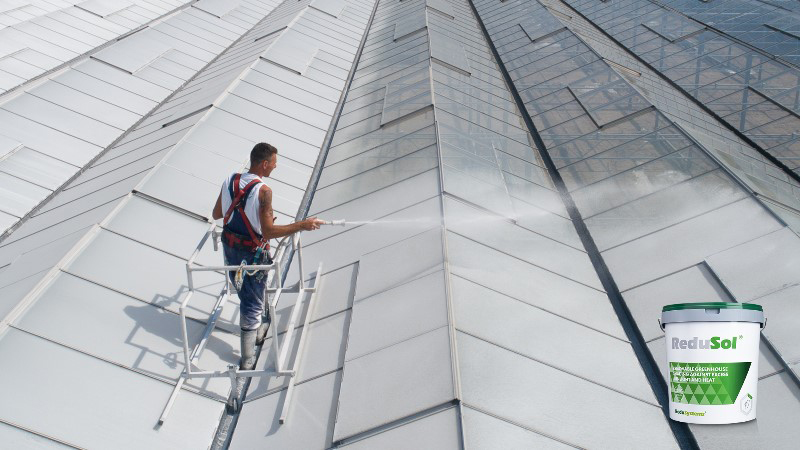Finishing Poinsettias Cooler

High fuel costs have our industry searching for opportunities to lower the thermostat, and poinsettias provide a unique opportunity for reducing greenhouse fuel inputs. Initially, the options may appear to be limited since poinsettias have historically not grown well at cooler temperatures. However, poinsettia has several attractive features. First, the scheduling and marketing calendar is identical from year to year. This makes it easier to compare data from previous years to determine how a current crop is progressing. Second, cooler temperatures can be compensated for by adding time to the front of the schedule. This is not usually a problem since greenhouse space is often available during the summer. Third, several new cultivars are extremely early to flower and thus a one- or two-week delay in flowering may be ideal for hitting the peak market dates.
In 2006, experimental trials were conducted at four greenhouses situated in different parts of the country to validate the effects of reduced greenhouse temperatures on poinsettia production under different environmental conditions, particularly the different light levels. The four greenhouses included: Kube-Pak (New Jersey), Smith Gardens (Washington), Post Gardens (Michigan) and Van Wingerden International (North Carolina). Van Wingerden International (VWI) conducted the trial at two separate sites (Mills River and Jeffress Road).
The cultivars selected for the trial included: ‘Advent Red,’ ‘Autumn Red,’ ‘Enduring Red,’ ‘Freedom Early Red,’ ‘Freedom Red’ and ‘Prestige Early Red.’ The normal market dates for each cultivar is as follows: ‘Advent Red’ (Nov. 1), ‘Freedom Early Red’ (Nov. 5), ‘Autumn Red’ (Nov. 10), ‘Freedom Red’ (Nov. 15), ‘Prestige Early Red’ (Nov. 18) and ‘Enduring Red’ (Nov. 20). At least 300 plants were grown per cultivar at each location.
The greenhouses followed a few basic guidelines. The crop was to be grown with 60ËšF night temperatures and 70ËšF to 75ËšF day temperatures when possible. Temperature and light data were recorded with a datalogger placed at the height of the canopy. Cycocel was the only plant growth regulator to be used, so bract size or timing was not influenced. Each site received cuttings one to two weeks before their regular crop schedule to compensate for any reduced vigor that might be observed under cool nights. Digital pictures were taken during flowering to evaluate bract development.
The average daily temperatures in the five greenhouse locations typically ranged from 60ËšF to 75ËšF during October and 55ËšF to 65ËšF in November. The temperatures were the warmest at the VWI Jeffress Road location while Smith Gardens remained cool throughout the season. In most locations, the average low temperature from mid-October through November was near 55ËšF. The high temperatures varied considerably between locations, ranging from the high 60s to the mid 80s.
Figure 1 displays the temperatures averaged weekly for each greenhouse. The average weekly temperatures at Post Garden were the coldest at 60ËšF to 63ËšF throughout October and November, while the Jeffress Road site dropped from 72ËšF to 63ËšF from early October to the end of November. In general, the average weekly temperatures during bract development were 60ËšF to 65ËšF.
Figure 2 displays DLI for each greenhouse. DLI is a light measurement that adds up all the individual measurements during the day. It represents the total light delivered to the crop during the day. For poinsettia, 10 moles/day is desirable during the vegetative phase (August and September), while 5 to 10 moles/day is acceptable for adequate bract development in October and November. Growing crops cooler actually improves plant quality when the ambient light levels are low (< 5 moles/day). The greenhouses in this study were near 10 moles/day in early October and then steadily dropped down to 5 moles/day in late November. Smith Gardens in Washington had the lowest light levels with as little as 2 moles/day throughout November.
First color in the cold greenhouses was, in general, less than one week different from the normal greenhouse crops. This indicates that the temperatures until first color were not greatly different from the normal growing regime, and perhaps it also suggests that flower initiation is primarily affected by photoperiod. At Kube-Pak, the cold crop was planted a week earlier ,so that helped to compensate for the slightly lower vigor. Also, it is interesting to note that the cold crop had a larger positive DIF, but this did not contribute to any excessive stem elongation
In general, bract development of each of the cultivars was slower in the cold greenhouses. At Kube-Pak Greenhouses, ‘Advent Red’ was marketable in early November. ‘Freedom Early Red’ was marketable in mid-November, ‘Autumn Red’ was marketable in mid to late November and ‘Prestige Early Red’ and ‘Freedom Red’ were marketable in late November. As you can see, bract development in the cold greenhouses was approximately one to two weeks slower than the normal flowering schedule for these cultivars. In some cases the timing difference and bract size difference was not as great as expected, which was attributed to the normal crop requiring more growth regulator than the cold crop, and the growth regulator caused a reduction in bract size and a slight delay in flowering. ‘Enduring Red’ did not perform uniformly at all locations. The magnitude of change in flower timing appears to be influenced not only by temperature but by variety as well; therefore, further trials will be conducted to better understand the interactions between temperature and bract development.
The results of this series of trials were considered to be a success, i.e., the crops were marketable and the participating growers have indicated that they will continue similar trials with additional cultivars this season. Additionally, controlled environment studies will be undertaken at Clemson University this season. The experimental studies will be conducted to gain a deeper understanding of the factors that influence bract development and to develop tools to assist growers in making low-temperature management decisions.
We anticipate growers will continue to incorporate cooler greenhouse temperatures into their poinsettia production planning. The Ecke Ranch will continue to develop techniques that will give growers more confidence in their ability to manage the poinsettia crop while reducing fuel inputs.
In summary, these trials conducted at commercial sites underscore the potential for reducing fuel costs on poinsettias while maintaining plant quality by following appropriate temperature reduction guidelines. We expect that this technique will become commonly used for growing poinsettias in the coming years.
Tips For Reducing Greenhouse Temperatures
If you are considering reducing greenhouse temperatures on some of your poinsettias this season, following is a checklist of important items to keep in mind:
-
Choose cultivars that are relatively early, so that a one- to three-week delay in flowering is useful. Keep these cultivars in separate greenhouses from later flowering poinsettias in order to avoid delaying the cultivars grown under the normal temperature regime.
-
For natural daylength crops, use normal temperatures until October 1, then the cold temperature regime can be started.
-
Be careful with excessive use of early season plant growth regulators since vigor is necessary to achieve the proper plant sizes. The large positive DIF delivered during the cold trials did not compensate for the lower average daily temperatures. It is likely that Cycocel alone is a sufficient growth regulator for cold poinsettia production.
-
Allow the greenhouse to warm up to between 75ËšF and 85ËšF during sunny days to offset the cooler night temperatures. On cloudy days, the temperatures should still reach the mid 70ËšFs to maintain bract development.
- Average daily temperatures should be maintained between 62ËšF and 65ËšF. Lower temperatures will likely delay flowering more than desired.
- The minimum night temperature should not fall below 55ËšF. Flower development will not progress at 50ËšF.
- Monitor root growth throughout the crop. Poor root growth may indicate that a crop or a cultivar is not doing well with the cold regime.
- Provide adequate air circulation and ventilation to reduce the humidity in the crop canopy and the greenhouse. Cold nights can cause excessive condensation in the humid plant canopy, which can lead to botrytis problems.
-
Maintain temperature and humidity sensors at the canopy height to provide an accurate picture of the crop environment.
-
Document your crops with a digital camera. Take weekly pictures and place a card with the cultivar name and date in the picture. This is an invaluable tool for evaluating the crop and making adaptations to future crops.









